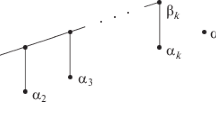Abstract
Asorting network is a combinational circuit for sorting constructed from comparison-swap units. The depth of such a circuit is a measure of its running time. It is known that sorting-network verification is computationally intractable. However, it is reasonable to hypothesize that only the fastest (that is, the shallowest) networks are likely to be fabricated. It is shown that the verification of shallow sorting networks is also computationally intractable. Firstly, a method for constructing asymptotically optimalsingle-exception sorting networks is demonstrated. These are networks which sort all zero-one inputs except one. More specifically, their depth isD(n-1)+2⌈log(n-1)⌉+2, whereD(n) is the minimum depth of ann-input sorting network. It follows that the verification problem for sorting networks of depth 2D(n)+6⌈logn⌉+O(1) is Co-NP complete. Given the current state of knowledge aboutD(n) for largen, this indicates that the complexity of verification for shallow sorting networks is as great as for deep networks.
Similar content being viewed by others
References
M. Ajtai, J. Komlós, and E. Szemerédi, AnO(n logn) sorting network,Proc. 15th Annual ACM Symposium on Theory of Computing, pp. 1–9, Boston, MA, Apr. 1983.
M. Ajtai, J. Komlós, and E. Szemerédi, Sorting inc logn parallel steps,Combinatorica, vol. 3, pp. 1–48, 1983.
K. E. Batcher, Sorting networks and their applications,Proc. AFIPS Spring Joint Computer Conference, vol. 32, pp. 307–314, Apr. 1968.
R. C. Bose and R. J. Nelson, A sorting problem,J. Assoc. Comput. Mach., vol. 9, pp. 282–296, 1962.
M. Chung and B. Ravikumar, On the size of test sets for sorting and related problems,Proc. 1987International Conference on Parallel Processing, Penn State Press, Aug. 1987.
M. J. Chung and B. Ravikumar, Strong nondeterministic Turing reduction—a technique for proving intractability,Proc. 2 Annual Conference on Structure in Complexity Theory, pp. 132–137, IEEE Computer Society Press, Ithaca, NY, June 1987.
M. J. Chung and B. Ravikumar, Strong nondeterministic Turing reduction—a technique for proving intractability,J. Comput. System Sci., vol. 39, no. 1, pp. 2–20, 1989.
R. L. Drysdale, Sorting networks which generalize Batcher's odd-even merge, Honors Paper, Knox College, May 1973.
R. W. Floyd and D. E. Knuth, The Bose-Nelson sorting problem, inA Survey of Combinatorial Theory, ed. J. N. Srivastava, North-Holland, Amsterdam, 1973.
D. Johnson, TheNP-completeness column: an on-going guide,J. Algorithms, vol. 3, no. 3, p. 298, Sept. 1982.
D. E. Knuth, Sorting and Searching,The Art of Computer Programming, vol. 3, Addison-Wesley, Reading, MA, 1973.
I. Parberry,Parallel Complexity Theory, Research Notes in Theoretical Computer Science, Pitman, London, 1987.
I. Parberry, Sorting networks, Technical Report CS-88-08, Dept. of Computer Science, Pennsylvania State Univ., Mar. 1988.
I. Parberry, A computer-assisted optimal depth lower bound for sorting networks with nine inputs,Proc. Supercomputing '89, ACM Press, NY, November 1989.
M. S. Paterson, Improved sorting networks withO(logn) depth, Research Report 89, Dept. of Computer Science, Univ. of Warwick, Jan. 1987.
D. C. Van Voorhis, An economical construction for sorting networks,Proc. AFIPS National Computer Conference, vol. 43, pp. 921–926, 1974.
Author information
Authors and Affiliations
Additional information
This research was supported by NSF Grant CCR-8801659.
Rights and permissions
About this article
Cite this article
Parberry, I. Single-exception sorting networks and the computational complexity of optimal sorting network verification. Math. Systems Theory 23, 81–93 (1990). https://doi.org/10.1007/BF02090767
Received:
Revised:
Issue Date:
DOI: https://doi.org/10.1007/BF02090767




